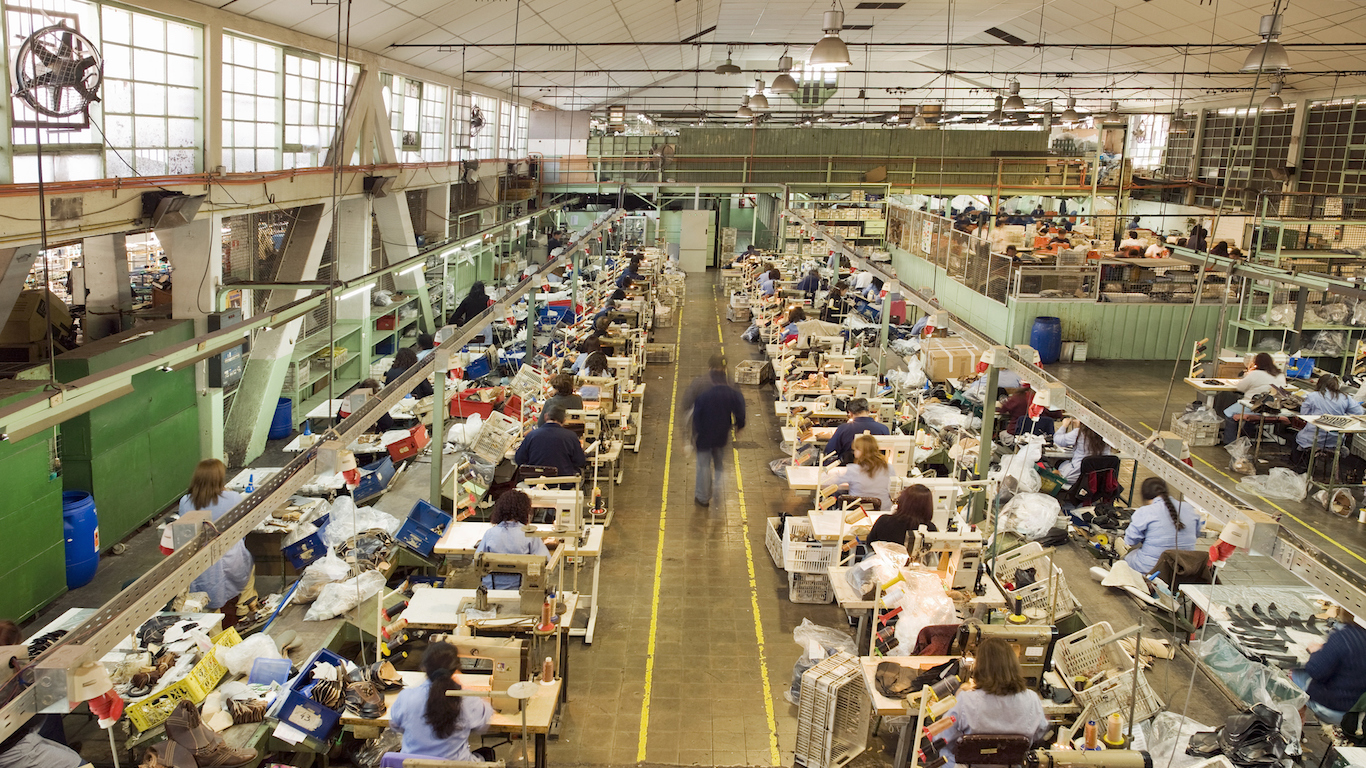
In 2017, 153.3 million Americans were employed in either full- or part-time jobs, up 5.4% from 2008. Job growth was not uniform across all industries, however. In many industries, the number of people employed shrank considerably, with some industries shedding more than half of their workforce.
Nearly all of the industries that lost a large share of their employees struggled to compete with advancements in technology. America’s increasing reliance on the internet and connected devices spelled disaster for printed media.
Technological advancement has also given way to increased automation in factories, reducing the need for workers. Many industries in the manufacturing sector were also affected by outsourcing. Operations affiliated with U.S. companies employ millions of workers overseas, and many of them are in industries that rank on this list.
24/7 Wall St. reviewed annual employment data from the Bureau of Labor Statistics from 2008 to 2017 to identify the fastest dying industries. Industries on this list had employment declines of at least 37% in the last decade. Eight industries lost over half of their workers during that time.
Due to automation, outsourcing, and the changing technological landscape, many of the industries that lost the most jobs over the past decade are expected to continue to struggle. Martin Kohli, chief regional economist for the U.S. Bureau of Labor Statistics, said that in the next decade publishing jobs will likely continue to decline. “Our 10 year projections did show continued shrinkage in print publishing” Kohli said.
Still, the publishing industry will not likely completely disappear. The continued existence of other industries on this list, like apparel and textile manufacturing, are less certain, according to Kohli.
To identify America’s 25 dying industries, 24/7 Wall St. reviewed employment change from 2008 through 2017 for U.S. industries in the fourth level of detail in the North American Industry Classification System by the Office of Management and Budget. All data, including the number of establishments within each industry and average weekly and annual wages, was retrieved from the U.S. Bureau of Labor Statistics’ Quarterly Census of Employment and Wages.
Click here to see America’s dying industries.

24. Book and periodical merchant wholesalers
> Employment change 2008-17: -37.6%
> Employment total: 36,184
> Wage growth 2008-17: +7.9%
> Avg. annual wage: $44,372
Book and periodical merchant wholesalers is one of many industries that has been hit hard by the rise in the digital media industry. As people increasingly read their book, magazine, and newspaper content online, book and periodical wholesales are seeing reduced demand from retailers. With the industry in decline, employment has dropped 37.6% over the past decade.
[in-text-ad]

23. Office supplies, except paper, manufacturing
> Employment change 2008-17: -37.6%
> Employment total: 11,198
> Wage growth 2008-17: +14.5%
> Avg. annual wage: $49,893
Once essential supplies like pens, pencils, staplers, and stamps are being phased out in offices worldwide. Instead of writing notes, people send emails. Instead of hard files, people file on a company server or cloud. As the industry has struggled, pay growth for those working to manufacture office supplies has been sluggish. Since 2008, pay in the industry has increased by just 14.5%. That slightly outpaced the U.S. cost of living increase, but fell well behind the pay growth in the vast majority of other industries.

22. Drywall and insulation contractors
> Employment change 2008-17: -38.0%
> Employment total: 241,401
> Wage growth 2008-17: -14.8%
> Avg. annual wage: $26,807
The number of new homes being built fell below one million for the first time since at least the 1950s in 2008, and remained there until 2014. This year, a decade after the housing market crash, employment for drywall and insulation contractors is about 38% below pre-crash levels. However, now that the housing market is more settled, the Bureau of Labor Statistics predicts employment in this industry will be relatively stable for the next several years.

21. Political organizations
> Employment change 2008-17: -38.4%
> Employment total: 7,728
> Wage growth 2008-17: -10.0%
> Avg. annual wage: $34,308
Though it seems the recent elections attracted everybody’s attention, the political organization industry shed 38.4% of its workers from 2008 to 2017. These include people working in political action committees, political parties, campaigns, and interest groups at the local, state, and national level. The industry was also one of the very few that saw its wages decline during that time frame as well. Political organization wages fell 10% over the past decade.
[in-text-ad-2]

20. Telephone apparatus manufacturing
> Employment change 2008-17: -40.1%
> Employment total: 19,475
> Wage growth 2008-17: +32.5%
> Avg. annual wage: $130,878
Since 2008, employment in the telephone apparatus manufacturing industry shrank by more than 40% to fewer than 20,000 workers. This industry largely produces products like wire telephones, cordless phones, and answering machines — all products that have been made virtually obsolete by the cell phone. In America, 95% of people have a cell phone of some kind. The share of people who have a smartphone has more than doubled since 2011, up to 77%. Traditional mounted phones lack the convenience and features of mobile phones and are being quickly phased out of the consumer market.

19. Textile and fabric finishing mills
> Employment change 2008-17: -41.3%
> Employment total: 23,253
> Wage growth 2008-17: +25.8%
> Avg. annual wage: $45,527
The textile and fabric finishing mills industry has been emblematic of the problems plaguing the U.S. manufacturing industry as a whole. Domestic textile manufacturers have been replaced by many U.S. apparel companies with manufacturers from developing countries from across the world to reduce costs. Employment in the industry is also falling due to increased automation in factories. In the past decade, the industry shed 41.3% of its workforce. Going forward, the industry may stand to benefit from tariffs on textiles imposed on China by the Trump administration.
[in-text-ad]

18. Cut and sew apparel contractors
> Employment change 2008-17: -41.5%
> Employment total: 35,926
> Wage growth 2008-17: +23.4%
> Avg. annual wage: $33,104
Apparel contractors who cut and sew fabrics owned by others for making clothing face many of the same issues that those in the textile industry face, particularly increasing competition from overseas. The cut and sew apparel contractors industry is one of just 21 U.S. industries that shed more than 40% of its workers over the last decade. From 2008 through 2017, there was a 41.5% decline in employment in the industry.

17. Tobacco manufacturing
> Employment change 2008-17: -41.8%
> Employment total: 12,184
> Wage growth 2008-17: +15.4%
> Avg. annual wage: $43,977
Tobacco manufacturing jobs have decreased significantly over the past decade, as tobacco use continues to decline. Over the last few decades, the health associated with smoking have become more well known, and the share of Americans who smoke has declined considerably, from 45% of U.S. adults in the 1950s to 16% today, an all-time low. Smokeless tobacco usage has increased in recent years, but not enough to offset the lower demand resulting from smokers quitting and younger Americans not taking up smoking.
Like other manufacturing jobs, falling employment in tobacco manufacturing is also attributable in part to automation’s ever increasing role in production.

16. Other telecommunications
> Employment change 2008-17: -42.4%
> Employment total: 80,395
> Wage growth 2008-17: +156.2%
> Avg. annual wage: $63,094
The telecommunications sector comprises companies involved in communication technology — primarily wireless operators, cable companies, and internet service providers. While employment in the wired and wireless telecommunications industry rose slightly over the past 10 years, employment in other, more specialized telecommunications activities — such as satellite tracking, communications telemetry, and radar station operation — declined 42.4% over the from 2008 to 2017, one of the largest declines of any industry.
[in-text-ad-2]

15. Stationery product manufacturing
> Employment change 2008-17: -42.6%
> Employment total: 17,336
> Wage growth 2008-17: +17.2%
> Avg. annual wage: $50,759
Stationery product manufacturing is one of many industries hurting due in part to the growing ubiquity of digital communication. While employment in the internet publishing industry nearly tripled over the past 10 years, the number of workers in stationery product manufacturing fell by 42.6%, one of the largest declines of any industry.
While, according to the Association for Print Technologies, employment in the industry is down overall, demand for speciality paper products, such as handcrafted journals, heavy cardstock, and Moleskine notebooks, is on the rise and may help to slow falling employment in the industry.

14. Other depository credit intermediation
> Employment change 2008-17: -42.6%
> Employment total: 10,889
> Wage growth 2008-17: +32.0%
> Avg. annual wage: $77,263
The pace of depository credit intermediation, or bank lending, declined substantially during the 2008 financial crisis and remains far below its pre-recession levels. In October, JPMorgan Chase, Citigroup, Wells Fargo, and PNC Financial Services reported year-over-year loan growth of just 2%, far less than in previous years. Employment in commercial banking fell by 2.2% from 2008 to 2017, and the number of workers in other depository credit intermediation activities — which includes industrial banks and private banks — fell by 42.6%.
While depressed lending activity can be an indication of low consumer confidence and slowing economic growth, some analysts say it is too early for alarm. Reduced lending activity can be a sign of a healthy economy, as companies with stronger revenues have less need to borrow.
[in-text-ad]

13. Book stores and news dealers
> Employment change 2008-17: -43.3%
> Employment total: 81,003
> Wage growth 2008-17: +22.5%
> Avg. annual wage: $38,779
With the growing use of digital media, from newspapers to magazines to books, as well as growing competition from online retailers, the book retailing industry has taken a battering. Amazon has about 50% of the U.S. market book market share, while the largest brick-and-mortar book retailer, Barnes & Noble, has about 20%. One in eight Barnes & Noble locations have shuttered in the past seven years. Overall, employment in the book stores and news dealers industry has declined by 43.3% from 2008 to 2017

12. Support activities for printing
> Employment change 2008-17: -44.2%
> Employment total: 23,920
> Wage growth 2008-17: +126.6%
> Avg. annual wage: $52,346
Support activities for printing is yet another industry struggling due in part to increased digitization — employment decline in the industry over the past decade was one of the largest. Fewer than 24,000 Americans remain working in the support activities for printing industry, down from nearly 43,000 in 2008. The industry includes book binding, embossing, and engraving. But books, magazines, and stationary are quickly being replaced with online versions of the products.

11. Other publishers
> Employment change 2008-17: -48.2%
> Employment total: 13,950
> Wage growth 2008-17: +24.1%
> Avg. annual wage: $32,154
Those in the other publishers industry work on publishing products other than newspapers, magazines, books, directories, mailing lists, or music. This may include items such as art prints, calendars, or greeting cards. This industry, like many other printing industries, struggles to compete with digital media. Traditional art print publishers now also compete with independent artists, who can print and sell their own work on a variety of online platforms like Etsy. Over the last decade, employment in the industry fell by 48.2%.
[in-text-ad-2]

10. Business and secretarial schools
> Employment change 2008-17: -48.3%
> Employment total: 7,063
> Wage growth 2008-17: +269.2%
> Avg. annual wage: $39,951
Business and secretarial schools offer courses in office procedures like secretarial skills, stenographic skills, and word processing. These duties are being replaced by automated procedures or executives are handling these tasks themselves as they become easier with advancements in technology. The BLS projects that secretary jobs will decline by 192,200 by 2026.
These bleak projections may be driving potential secretaries away from secretarial school and into different professions. The number of people working in business and secretarial schools has declined by 48.3% over the past decade.

9. Land subdivision
> Employment change 2008-17: -49.3%
> Employment total: 40,207
> Wage growth 2008-17: +35.5%
> Avg. annual wage: $71,744
The U.S. housing market is beginning to return to normal following the Great Recession and housing market crash. Housing starts in 2017 were similar to 2007 levels, before the crash. The land subdivision industry, which divides land into parcels for housing and other purposes, suffered as a result of the market’s struggles. As of 2017, industry employment is just about half of what it was a decade before.
[in-text-ad]

8. Newspaper publishers
> Employment change 2008-17: -50.3%
> Employment total: 160,739
> Wage growth 2008-17: -17.8%
> Avg. annual wage: $32,765
Newspaper publishing is one of only eight U.S. industries that employs less than half as many workers as it did in 2008. There are now just 160,739 newspaper publishers workers in the United States, compared to more than 320,000 a decade earlier. While people still read newspapers, many who do subscribe to the digital version, reducing the need for those who print physical copies. Industry workers today are making less money than industry workers in 2008. Since that time, the industry’s average annual wages dropped 17.8%, one of the larger declines of any industry.

7. Hosiery and sock mills
> Employment change 2008-17: -51.2%
> Employment total: 7,544
> Wage growth 2008-17: -11.6%
> Avg. annual wage: $31,243
Hosiery and sock mills are facing challenges on two fronts. Many of these products, which were once made by hand, are now being mass-manufactured by machines. These mills now need far fewer people to operate. Other hosiery and sock mills are being undercut by foreign competitors. Total industry employment declined by 51.2% since 2008. In that same time, average annual wages have also declined by 11.6% for those who still work in hosiery and sock mills.

6. Directory and mailing list publishers
> Employment change 2008-17: -56.0%
> Employment total: 19,709
> Wage growth 2008-17: +19.0%
> Avg. annual wage: $76,446
The convenience of the internet is driving the directory and mailing list publisher industry out of business. Over the past decade, the industry’s employment has dropped by 56%. Most small businesses have a website, and that number is continuing to increase. Some people still use resources like the Yellow Pages to look for businesses in their area, but fewer do every day and those who do tend to be in the 55 and older demographic. As a result, the industry struggles and will likely continue to struggle.
[in-text-ad-2]

5. Photofinishing
> Employment change 2008-17: -57.9%
> Employment total: 9,006
> Wage growth 2008-17: +58.7%
> Avg. annual wage: $55,048
More and more Americans choose to share their photos online rather than print a physical copy. Photofinishing industry workers continue to feel the sting from this development in technology, as there are 57.9% fewer people working in the industry now than there were in 2008. With the advent of digital cameras and smartphones, people can instantly snap, edit, and share their photos digitally, eliminating the need for a middleman in most cases.

4. Magnetic media manufacturing and reproducing
> Employment change 2008-17: -58.7%
> Employment total: 14,449
> Wage growth 2008-17: +54.0%
> Avg. annual wage: $114,011
Since 2008, most jobs in magnetic media manufacturing have disappeared. These positions, which involve making audio and video tapes as well as floppy disks, have largely become irrelevant as Americans become less reliant on physical media in favor of streaming and cloud storage services. Streaming media services like Netflix and digital downloads of films on services like iTunes are phasing out older technology. From 2008 to 2017, employment in this industry dropped from more than 30,000 workers to 14,449.
[in-text-ad]

3. Port and harbor operations
> Employment change 2008-17: -59.9%
> Employment total: 10,635
> Wage growth 2008-17: +8.7%
> Avg. annual wage: $49,979
Jobs at ports and harbors such as cargo handling and ship navigation are being phased out by automation. Machines and computers are able to accomplish these tasks with more speed and precision and at a reduced cost. Nearly 60% of port and harbor operations jobs have been eliminated in the past decade.
Even as jobs in ports and harbors decline, the industry still is incredibly important to the U.S. economy. The economic impact of U.S. port was $4.6 trillion in 2014, or more than a quarter of U.S. economic output.

2. Women’s, girls’, infants’ cut-sew apparel mfg
> Employment change 2008-17: -61.5%
> Employment total: 22,248
> Wage growth 2008-17: +41.6%
> Avg. annual wage: $58,204
Many clothing and manufacturing jobs have been hit hard over the past decade by both outsourcing and automation. The women’s, girls’, infants’ cut-sew apparel manufacturing industry has been no exception. The industry makes apparel for women, girls, and infants from purchased fabric. The number of Americans working in this industry declined by more than 61% in the past decade.

1. Other apparel knitting mills
> Employment change 2008-17: -64.0%
> Employment total: 3,740
> Wage growth 2008-17: +15.1%
> Avg. annual wage: $37,852
There were 229 mills classified as other apparel knitting mills in 2008. These are places that knit outerwear, underwear, and nightwear. A decade later, the number of these types of mills fell to 139. During that period, employment in the industry fell by 64%, the steepest decline of any industry. Across many apparel manufacturing industries, outsourcing and automation are reducing the overall employment.
Are You Ahead, or Behind on Retirement? (sponsor)
If you’re one of the over 4 Million Americans set to retire this year, you may want to pay attention. Many people have worked their whole lives preparing to retire without ever knowing the answer to the most important question: are you ahead, or behind on your retirement goals?
Don’t make the same mistake. It’s an easy question to answer. A quick conversation with a financial advisor can help you unpack your savings, spending, and goals for your money. With SmartAsset’s free tool, you can connect with vetted financial advisors in minutes.
Why wait? Click here to get started today!
Thank you for reading! Have some feedback for us?
Contact the 24/7 Wall St. editorial team.
 24/7 Wall St.
24/7 Wall St. 24/7 Wall St.
24/7 Wall St.


